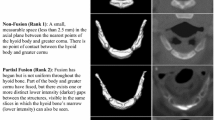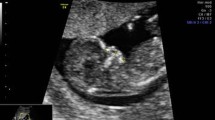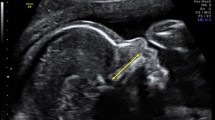Abstract
It was aimed that the morphometric development of the hyoid bone throughout the fetal period be anatomically researched and its clinical importance be evaluated. A total of 90 human fetuses (44 male, 46 female) whose ages varied between 18 and 40 gestational weeks and without an external pathology or anomaly were involved in the study. The fetuses were divided into groups according to gestational weeks and trimesters. In the wake of making the general external measurements of fetuses, the neck dissection was performed. Following the localization of the hyoid bone, the morphometric parameters pertaining to the hyoid bone were measured. The averages of the measured parameters according to the gestational weeks, trimesters and months, and their standard deviations were determined. There was a significant correlation between the measured parameters and the gestational age (p < 0.001). Between the genders, there was no difference among the other parameters, except for those regarding the distance between the hyoid bone and columna vertebralis, the hyoid bone corpus length, the hyoid bone right cornu majus initial width, the hyoid bone left cornu majus initial width, and the upper distance between the hyoid bone cornu majus (es) (p > 0.001). We are of the opinion that the data obtained during our study will be of use to forensic physicians and the involved clinicians in the evaluation of the development of the hyoid bone area during the fetal period, and in clinical studies and practices.


Similar content being viewed by others
References
Balseven-Odabasi A, Yalcinozan E, Keten A, Akçan R, Tumer AR, Onan A et al (2013) Age and sex estimation by metric measurements and fusion of hyoid bone in a Turkish population. J Forensic Leg Med 20(5):496–501
El Amm CA, Denny A (2008) Hyoid bone abnormalities in Pierre Robin patients. J Craniofac Surg 19(1):259–263
Ito K, Ando S, Akiba N, Watanabe Y, Okuyama Y, Moriguchi H et al (2012) Morphological study of the human hyoid bone with three-dimensional CT images—Gender difference and age-related changes. Okajimas Folia Anat Jpn 89(3):83–92
Kim DI, Lee UY, Park DK, Kim YS, Han KH, Kim KH et al (2006) Morphometrics of the hyoid bone for human sex determination from digital photographs. J Forensic Sci 51(5):979–984
Kindschuh SC, Dupras TL, Cowgill LW (2010) Determination of sex from the hyoid bone. Am J Phys Anthropol 143(2):279–284
Komenda S, Cerny M (1990) Sex determination from the hyoid bone by means of discriminant analysis. Acta Univ Palacki Olomuc Fac Med 125:37–51
Leksan I, Marcikić M, Nikolić V, Radić R, Selthofer R (2005) Morphological classification and sexual dimorphism of hyoid bone: new approach. Coll Antropol 29(1):237–242
Levine E, Taub PJ (2006) Hyoid bone fractures. Mt Sinai J Med 73(7):1015–1018
Malas MA, Sulak O, Çetin M, Salbacak A (2000) Radiological anatomy of hyoid bone. Turkiye Klinikleri J Med Sci 20:149–153
Miller KW, Walker PL, O’Halloran RL (1998) Age and sex-related variation in hyoid bone morphology. J Forensic Sci 43(6):1138–1143
Moore KL (1992) Clinically oriented anatomy, 3rd edn. Baltimore, USA, Williams&Wilkins, p 783
Moore KL, Persaud TVN (2009) The Developing Human: Clinically Oriented Embryology. Yıldırım M, Dalçık H, (trans. edt.) Human Embryology (8th ed) Nobel Tıp Kitabevleri, İstanbul, pp 97–103, 164
Mukhopadhyay PP (2010) Morphometric features and sexual dimorphism of adult hyoid bone: a population specific study with forensic implications. J Forensic Leg Med 17(6):321–324
Mukhopadhyay PP (2012) Determination of sex from an autopsy sample of adult hyoid bones. Med Sci Law 52(3):152–155
O’Halloran RL, Lundy JK (1987) Age and ossification of the hyoid bone: forensic implications. J Forensic Sci 32(6):1655–1659
Papadopoulos N, Lykaki-Anastopoulou G, Alvanidou E (1989) The shape and size of the human hyoid bone and a proposal for an alternative classification. J Anat 163:249–260
Park SA, Lee JH, Nam YS, An X, Han SH, Ha KY (2013) Topographical anatomy of the anterior cervical approach for c2-3 level. Eur Spine J 22(7):1497–1503
Pollanen MS, Ubelaker DH (1997) Forensic significance of the polymorphism of hyoid bone shape. J Forensic Sci 42(5):890–892
Saternus KS, Koebke J (1979) Injury pattern of the hyoid bone. Z Rechtsmed 84(1):19–35
Standring S, Ellis H, Healy JC, Johnson D, Williams A, Collins P et al (2008) Gray’s Anatomy: the anatomical basis of clinical practite, 40th edn. Churchill Livingstone p, Spain 436
Soerdjbalie-Maikoe V, Van Rijn RR (2008) Embryology, normal anatomy, and imaging techniques of the hyoid and larynx with respect to forensic purposes: a review article. Forensic Sci Med Pathol 4(2):132–139
Urbanova P, Hejna P, Zatopkova L, Safr M (2013) What is the appropriate approach in sex determination of hyoid bones? J Forensic Leg Med 20(8):996–1003
Conflict of interest
The authors declare no conflict of interest.
Author information
Authors and Affiliations
Corresponding author
Rights and permissions
About this article
Cite this article
Kadir, D., Osman, S. & Mehmet Ali, M. The morphometric development and clinical importance of the hyoid bone during the fetal period. Surg Radiol Anat 37, 43–54 (2015). https://doi.org/10.1007/s00276-014-1319-1
Received:
Accepted:
Published:
Issue Date:
DOI: https://doi.org/10.1007/s00276-014-1319-1




